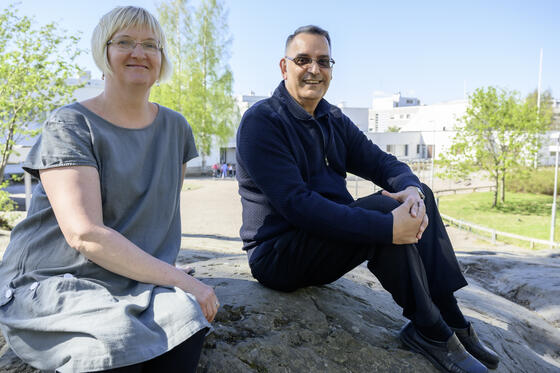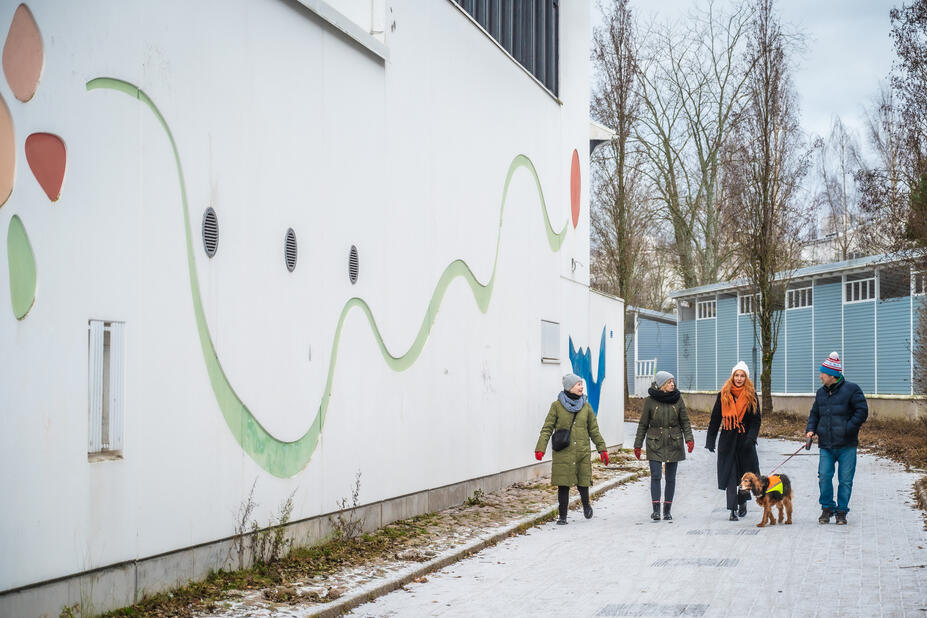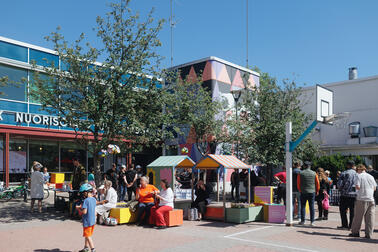Close to nature, versatile, multi-faceted, quite peaceful. This is how community worker Minna Suoknuuti describes Meri-Rastila. Social instructor Henry Bollström nods in agreement.
Bollström can be said to be a specialist of the area, as he not only works in the area, but has also lived there since 1994.
We meet in the middle of the Meri-Rastila Cultural Space, Merirasti, which across the street from the school, familiar to Bollström through his children having gone there. His daughter has worked at the youth centre next door.
Suoknuuti and Bollström pile on more typical features of the area: the multicultural and active residents and its village-like character. Resident activity has been particularly visible, especially of late, when the city announced its plans to give Meri-Rastila a new look as one of the targets of urban renewal.
Urban renewal means that old residential areas will be renovated and new apartments and services will be built in them. Development in the area also serves to prevent segregation.
The local residents are very interested in the development. In the spring, Pro Meri-Rastila and the Vuosaari Society invited city representatives to Merirasti to talk about the plans for the area and answer questions from residents.
“I was surprised about how many people showed up. We even ran out of chairs.
The duo describes the event as active and constructive. The crowd had clearly prepared well for the event, as evidenced by their questions. Although not every plan is to everyone's liking, the discussions were civil and the spirit of the event was positive.
Meri-Rastila shows the same trend as the rest of Helsinki: some residents are very active, while others are difficult to reach to hear their opinions. There is a particular desire to see the participation of residents who have moved from out of town.
Sense of community – one of the features of Meri-Rastila
One of the features of Meri-Rastila could be said to be its sense of community. The Meri-Rastila network got started immediately the area was completed in the 1990s. In the early days, network meetings mainly focused on the development of the area from an official perspective. Since then, the network has expanded to include representatives from NGOs, the congregation and businesses in addition to residents.
Today, diverse matters are talked about in a variety of ways, from different perspectives. At the meetings, people agree on who will advance which thing. City employees are responsible for sharing current affairs from their organisations.
Dialogue is an important part of urban renewal
Urban renewal is happening in Meri-Rastila with two significant patterns, one for the eastern side and another for the western side of the area. At the same time, the area’s service offering will receive an overhaul. All in all, it will take more than a decade to implement the reforms.
New apartments will be built especially near the metro station as well as on the edges of the green areas. New homes are planned for more than 4,000 residents.
When some of the old buildings are demolished to make way for new ones, these works will also concurrently improve the parks, squares, transport connections, and public and commercial services.
City services will be consolidated in a new multipurpose community centre, which will contain the comprehensive school, daycare centre, youth centre, home care services, a playground and resident facilities.
Suoknuuti and Bollström believe that the city has its hands full to communicate matters sufficiently and rapidly, because the need for information is great. However, there are still many things that are undecided and without clear details. The duo must therefore tell their customers or residents they meet occasionally that there is nothing more they can share about what’s being prepared.
Among other things, discussions with residents raise concerns about when the shopping centre and apartments will be demolished. The new multipurpose community centre also raises questions. Is there room for spontaneous encounters with residents and for holding small events?
The youth centre will remain at a central location in the new community centre. This is important, as many children and young adults live in the area.
Merirasti activities as an example of urban renewal
The infill development of Meri-Rastila is planned to start in 2025–2026 for the western part, around the business centre area and the Haruspuisto park.
Work is expected to last until the 2030s. The start-up of construction sites is affected by the schedules of those involved in the project and the landowners, among other things.
Suoknuuti and Bollström say that the urban renewal is already emergent in smaller development. A good example of this is Cultural Space Merirasti, which is run by the Culture and Leisure Division through additional funding for urban renewal.
Merirasti hosts a wide range of activities and events. The space houses Theatre House Universum's Story Sharing Universum project, which aims to reduce prejudice and racism and promote equality by sharing stories.
Suoknuuti and Bollström think that Meri-Rastila is a good area to work in. They believe that it will improve through the support of urban renewal. The setting is great, with the magnificent seafront and nearby nature. They are well-loved by the residents, as are the parks that are in active use.
The adjacent Rastila campsite makes the area into something like the city's business card for tourists, as many of them come to Meri-Rastila for grocery shopping. The duo points out that for this reason alone, it is worthwhile for the city to develop the area into being even more impressive.
Urban renewal improves comfort and attractiveness
Urban renewal will continue until 2035 in Malminkartano and Kannelmäki, Malmi, Mellunkylä and Meri-Rastila. The built environment in these areas has reached the stage of its life cycle where repairs are due. All urban renewal areas are located along good rail connections.
Urban renewal is one of the measures of the Place for Growth strategy, as well as one way to prevent segregation. The City of Helsinki focusing on the development of school and leisure services in urban renewal areas in particular. One of the most important tasks is to listen to the areas’ residents and actors and to carry their message forward. In urban renewal, cooperation plays a key role.
Urban renewal aims to improve the amenities and attractiveness in residential areas and enable high-quality infill development.
Helsinki’s goal is to be a city where residential areas are not segregated and where it’s possible to positively live a safe and enjoyable life in every unique district.




